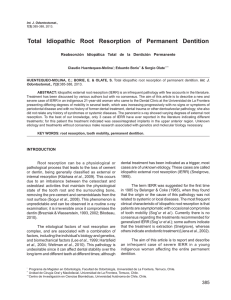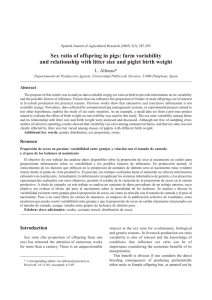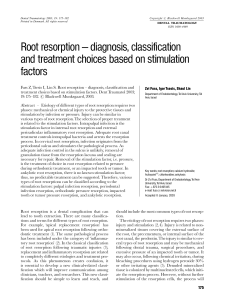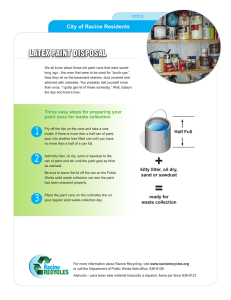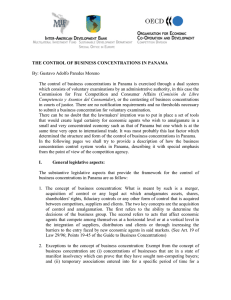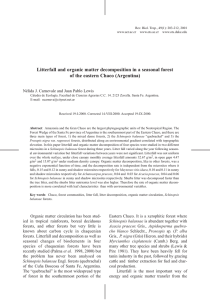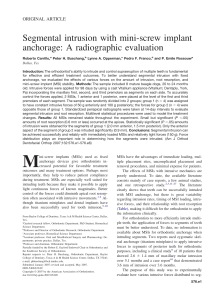English
Anuncio
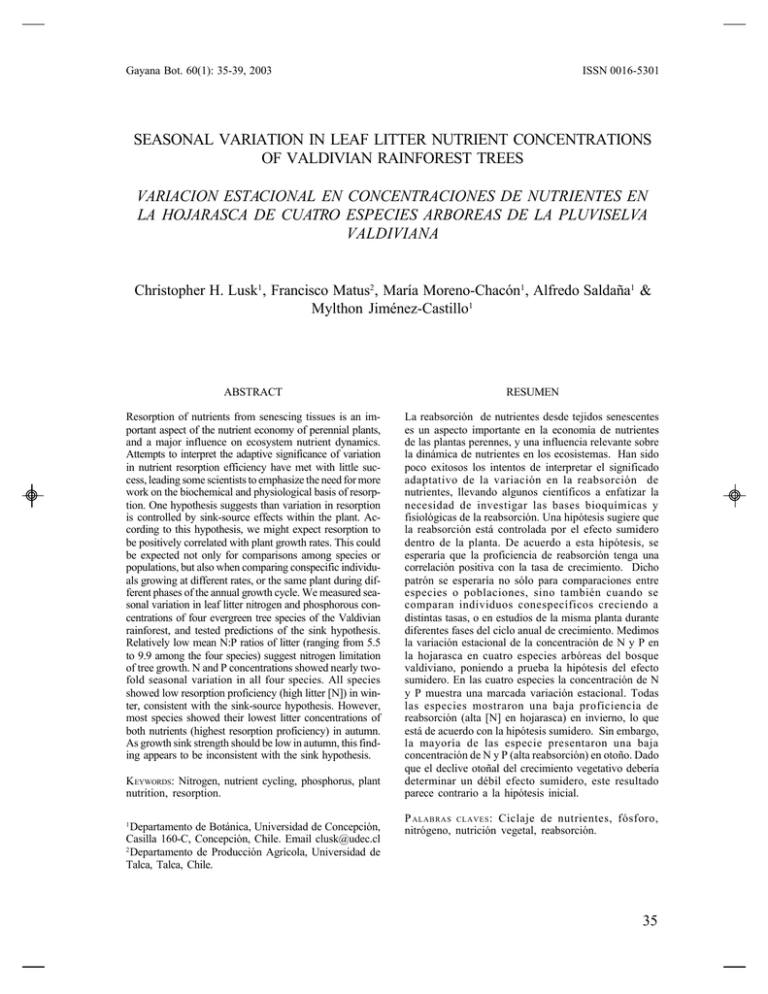
Gayana Bot. 60(1): 35-39, 2003 ISSN 0016-5301 SEASONAL VARIATION IN LEAF LITTER NUTRIENT CONCENTRATIONS OF VALDIVIAN RAINFOREST TREES VARIACION ESTACIONAL EN CONCENTRACIONES DE NUTRIENTES EN LA HOJARASCA DE CUATRO ESPECIES ARBOREAS DE LA PLUVISELVA VALDIVIANA Christopher H. Lusk1 , Francisco Matus2 , María Moreno-Chacón1 , Alfredo Saldaña1 & Mylthon Jiménez-Castillo1 ABSTRACT RESUMEN Resorption of nutrients from senescing tissues is an important aspect of the nutrient economy of perennial plants, and a major influence on ecosystem nutrient dynamics. Attempts to interpret the adaptive significance of variation in nutrient resorption efficiency have met with little success, leading some scientists to emphasize the need for more work on the biochemical and physiological basis of resorption. One hypothesis suggests than variation in resorption is controlled by sink-source effects within the plant. According to this hypothesis, we might expect resorption to be positively correlated with plant growth rates. This could be expected not only for comparisons among species or populations, but also when comparing conspecific individuals growing at different rates, or the same plant during different phases of the annual growth cycle. We measured seasonal variation in leaf litter nitrogen and phosphorous concentrations of four evergreen tree species of the Valdivian rainforest, and tested predictions of the sink hypothesis. Relatively low mean N:P ratios of litter (ranging from 5.5 to 9.9 among the four species) suggest nitrogen limitation of tree growth. N and P concentrations showed nearly twofold seasonal variation in all four species. All species showed low resorption proficiency (high litter [N]) in winter, consistent with the sink-source hypothesis. However, most species showed their lowest litter concentrations of both nutrients (highest resorption proficiency) in autumn. As growth sink strength should be low in autumn, this finding appears to be inconsistent with the sink hypothesis. La reabsorción de nutrientes desde tejidos senescentes es un aspecto importante en la economía de nutrientes de las plantas perennes, y una influencia relevante sobre la dinámica de nutrientes en los ecosistemas. Han sido poco exitosos los intentos de interpretar el significado adaptativo de la variación en la reabsorción de nutrientes, llevando algunos científicos a enfatizar la necesidad de investigar las bases bioquímicas y fisiológicas de la reabsorción. Una hipótesis sugiere que la reabsorción está controlada por el efecto sumidero dentro de la planta. De acuerdo a esta hipótesis, se esperaría que la proficiencia de reabsorción tenga una correlación positiva con la tasa de crecimiento. Dicho patrón se esperaría no sólo para comparaciones entre especies o poblaciones, sino también cuando se comparan individuos conespecíficos creciendo a distintas tasas, o en estudios de la misma planta durante diferentes fases del ciclo anual de crecimiento. Medimos la variación estacional de la concentración de N y P en la hojarasca en cuatro especies arbóreas del bosque valdiviano, poniendo a prueba la hipótesis del efecto sumidero. En las cuatro especies la concentración de N y P muestra una marcada variación estacional. Todas las especies mostraron una baja proficiencia de reabsorción (alta [N] en hojarasca) en invierno, lo que está de acuerdo con la hipótesis sumidero. Sin embargo, la mayoría de las especie presentaron una baja concentración de N y P (alta reabsorción) en otoño. Dado que el declive otoñal del crecimiento vegetativo debería determinar un débil efecto sumidero, este resultado parece contrario a la hipótesis inicial. KEYWORDS: Nitrogen, nutrient cycling, phosphorus, plant nutrition, resorption. 1 Departamento de Botánica, Universidad de Concepción, Casilla 160-C, Concepción, Chile. Email clusk@udec.cl 2 Departamento de Producción Agrícola, Universidad de Talca, Talca, Chile. P ALABRAS CLAVES : Ciclaje de nutrientes, fósforo, nitrógeno, nutrición vegetal, reabsorción. 35 Gayana Bot. 60(1), 2003 INTRODUCTION Retranslocation of nutrients from senescing tissues, often referred to as “resorption” (Killingbeck 1986), is an important aspect of the nutrient economy of perennial plants, and a major influence on ecosystem nutrient dynamics. Most perennials resorb 40 – 65 % of nitrogen and phosphorus from leaves before abscission (Aerts 1996), permitting these nutrients to be recycled internally and used in the construction of new tissues. Ecologists have often hypothesized that plants native to poor soils should have lower nutrient loss rates than those from more fertile habitats (Grime 1979; Chapin 1980; Berendse & Aerts 1987). Nutrient resorption from senescing leaves might therefore be expected to be more highly developed in low fertility environments. However, although there is wide intra- and interspecific variation in nutrient resorption, a comprehensive literature review by Aerts (1996) suggested that this variation is not strongly related to nutrient availability. Aerts (1996) concluded that future studies should concentrate on elucidating biochemical, rather than ecological, controls on resorption. One interesting possibility is that resorption is influenced by sink strength within the plant (Nambiar & Fife 1991). According to this hypothesis, we might expect resorption efficiency to be positively correlated with plant growth rates, as rapid production of new tissues should constitute a strong nutrient sink. This could be expected not only for comparisons among species or populations, but also when comparing conspecific individuals growing at different rates, or the same plants during different phases of the annual growth cycle. Here we present data on seasonal variation in litter nitrogen and phosphorous concentrations of four evergreen tree species of the Valdivian rainforest, and test predictions of the growth sink hypothesis. If sink effects were an important control on nutrient resorption, then litter nutrient concentrations might be expected to be highest in winter, when there is little or no growth in temperate climates. On the other hand, litter nutrient concentrations should be lowest during periods when rapid growth generates strong sinks, especially during spring. As here we do not present data on nutrient concentrations of fresh foliage, our data are indicative of resorption proficiency (sensu Killingbeck 1996) rather than resorption efficiency. MATERIALS AND METHODS STUDY AREA Sampling was carried out in the low-altitude forests (350-440 m a.s.l.) of Parque Nacional Puyehue (40º 39’S, 72º 11’W) located in the western foothills of the Andean range in south-central Chile. This area experiences a maritime temperate climate, with an average annual precipitation of around 3,500mm (Almeyda & Sáez 1958). The old-growth rain forest at this altitude on the western foothills of the Andes is comprised exclusively of broadleaved evergreen species. Bamboos of the genus Chusquea are common beneath large canopy openings (Lusk 2001). Soils under the old-growth forest have moderate levels of total nitrogen (0.7 %) and available phosphorus (6 ppm) (C. Lusk, unpublished data). TABLE I. Leaf litter traits of study species. Mean values are not weighted for seasonal variation in litter production. Species Family Symbol Mean [N] (%) Mean [P] (%) Mean N:P Aextoxicon punctatum R. et P. Eucryphia cordifolia Cav. Aextoxicaceae Ap 0.62 0.12 5.6 Cunoniaceae Ec 0.44 0.04 9.9 Laurelia philippiana Looser Atherospermataceae Lp 0.84 0.12 7.1 Nothofagus dombeyi (Mirb.) Oerst. Fagaceae Nd 0.55 0.06 9.0 36 Seasonal variation in nutrient resorption: LUSK, C. ET AL. TABLE II. ANOVA showing effects of species and season on litter nutrient concentrations. Source of variation d.f. Sum of squares F-ratio P<F (a) Nitrogen Month Species Month x species 3 3 9 1.17 1.35 0.37 26 29.9 2.7 <.0001 <.0001 0.0128 3 3 9 0.01 0.07 0.00 10.8 70 1.1 <.0001 <.0001 0.3754 (b) Phosphorus Month Species Month x species FIGURE 1. Seasonal variation in nitrogen content (mean ± s.e.) of leaf litter in four tree species of old growth Valdivian rainforest, Puyehue, Chile. Species symbols as in Table I. FIGURE 2. Seasonal variation in phosphorus content (mean ± s.e.) of leaf litter in four tree species of old growth Valdivian rainforest, Puyehue, Chile. Species symbols as in Table I. 37 Gayana Bot. 60(1), 2003 LITTER COLLECTION AND ANALYSIS Four plots of 25 m x 25 m were sited subjectively in closed canopy old-growth stands. Ten 0.5 m2 litter traps were randomly located in each plot. Traps were constructed from fine nylon mesh attached to a wooden frame, and were suspended at 20 to 40 cm height above the forest floor. Litter was collected during four months selected as representative of autumn (May), winter (August), spring (November) and summer (February), and dried at 65 º C within five days of each collection date. Litter was then separated by species and organ (leaf, wood, fruits), dried and weighed again. Leaf litter samples of four common overstorey tree species (Table 1) were analysed for nitrogen and phosphorus content at the Laboratorio de Análisis de Suelos y Plantas, Universidad de Concepción. Litter from each plot was analysed separately, treating each plot as a replicate for statistical purposes. Effects of species and season on litter nutrient concentrations were analysed by ANOVA using JMP Statistical Software (SAS Institute, Cary, NC). RESULTS Average litter N concentrations, unweighted for seasonal variation in litter production, ranged from 0.44 % in Eucryphia cordifolia to 0.84 % in Laurelia philippiana (Table I). P concentrations ranged from 0.04 % in E. cordifolia to 0.12 % in L. philippiana and Aextoxicon punctatum. Mean N:P ratios of litter ranged from 5.6 in A. punctatum to 9.9 in E. cordifolia. All four species showed roughly two-fold seasonal variation in leaf litter concentrations of both N and P (Fig. 1,2). In most cases, concentrations were lowest in autumn, and highest in winter. ANOVA showed that concentrations of both N and P differed significantly among species and among seasons (Table II). In the case of N, there was also evidence that the seasonal pattern of variation differed significantly among species. DISCUSSION The N:P ratios documented here are all below the average reported in a review by Killingbeck (1996), 38 which might indicate nitrogen limitation of tree growth at our site. This is in keeping with their growing on a young volcanic soil with a high sand fraction, where nitrogen limitation seems likely. Although seasonal variation in litter nutrient concentrations has been previously described (Arunachalama et al. 1998; Cuevas & Lugo 1998), we are not aware of any previous studies reporting variation as wide that evident in our data (Fig. 1, 2). This finding implies a cautionary note for studies of nutrient fluxes in leaf litter and resorption efficiency. Considerable biases in estimates of resorption efficiency, or of annual nutrient fluxes, could result from sampling at a single date, or from multiple-date sampling without weighting for seasonal variation in litter production. Although we attribute seasonal patterns in litter nutrient concentrations to changes in resorption efficiency, variation in the contribution of stormdowned green foliage could also influence our data (Cuevas & Lugo 1998). Thus, the high litter nutrient concentrations in August could to some degree reflect the higher frequency of violent storms during the winter. One way of controlling this factor would be to analyze litter nutrient concentrations of understorey species, which are largely shielded from storm damage. There was limited support for the idea that strength of growth sinks is a major control on nutrient resorption efficiency (Nambiar & Fife 1991). As predicted by this hypothesis, litter nutrient concentrations were generally highest in winter, consistent with low resorption efficiency during the season when growth sinks should be weakest (Fig. 1, 2). However, litter concentrations of both nutrients were generally lowest in autumn, indicating high resorption during another period when growth sink strength would be expected to be low. In contrast, the growth sink hypothesis predicts that resorption should be strongest during periods of vigorous growth, especially spring. This study is not the first to cast doubts upon the growth sink hypothesis, as Chapin & Moilanen (1991) noted that sink strength is unlikely to explain the strong resorption shown by many deciduous trees in autumn. What could drive high resorption during autumn, when vegetative growth is drawing to a close? Transport of resources to storage organs, and seed set, could generate important sinks during autumn. However, there seems no reason to expect Seasonal variation in nutrient resorption: LUSK, C. ET AL. these sinks to be stronger than those generated by rapid expansion of tissues in spring, suggesting that these possibilities are unlikely to explain the overall seasonal pattern observed in this study. Furthermore, seeds of most of the study species are mature (and in some cases, already dispersed) by May, the autumn month of litter collection (SmithRamírez & Armesto 1994). Some evidence from both inter- and intraspecific comparisons suggests that the influences of plant hormone systems on resorption efficiency may warrant study. In an extensive comparative study in Spain, Del Arco et al. (1991) found that species with strongly seasonal patterns of leaf loss tended to have higher resorption than those showing more gradual and continuous foliage senescence. Similarly, Cuevas & Lugo (1998) noted that nutrient litter concentrations of most tropical plantation species in Puerto Rico were lowest during periods of high litter production. High concentrations of ethylene during peak periods of leaf senescence (Buchanan et al. 1999) could simultaneously favor high resorption efficiency. We therefore suggest that future studies would do well to explore the influence of hormonal integration on variation in nutrient resorption. ACKNOWLEDGMENTS We thank FONDECYT for support through grant 1000367, and Roberto Godoy and Carlos Oyarzún for the invitation to participate in this symposium. REFERENCES AERTS, R. 1996. Nutrient resorption from senescing leaves of perennials: are there general patterns? Journal of Ecology 84: 597-608. ALMEYDA, E. & F. SAEZ . 1958. Recopilación de datos climáticos de Chile y mapas sinópticos respectivos. Ministerio de Agricultura, Santiago, Chile. ARUNACHALAMA, A., K.M. ARUNACHALAMA, H.N. PANDEYB & R.S. TRIPATHIB 1998. Fine litterfall and nutrient dynamics during forest regrowth in the humid subtropics of north-eastern India. Forest Ecology and Management 110: 209-219. BERENDSE, F. & R. AERTS. 1987. Nitrogen-use efficiency: a biologically-meaningful definition? Functional Ecology 1: 293-296. BUCHANAN , R., W. GRUISSEM & R.L. JONES. 1999. Biochemistry & Molecular Biology of Plants. Wiley, New Jersey. 1408 pp. CHAPIN, F.S. 1980 The mineral nutrition of wild plants. Annual Review of Ecology & Systematics 11: 233260. CHAPIN, F.S. & L. MOILANEN. 1991. Nutritional controls over nitrogen and phosphorus resorption from Alaskan birch leaves. Ecology 72: 709-715. CUEVAS, E. & A.E. LUGO. 1998. Dynamics of organic matter and nutrient return from litterfall in stands of ten tropical tree plantation species. Forest Ecology and Management 112: 263-279. DEL ARCO, J.M.,A. ESCUDERO & M.V. GARRIDO. 1991. Effects of site characteristics on nitrogen retranslocation from senescing leaves. Ecology 72: 701-708. GRIME, J.P. 1979. Plant strategies and vegetation processes. Wiley, Chichester. 222 p. KILLINGBECK, K.T.1986. The terminological jungle revisited: making a case for use of the term resorption. Oikos 46: 263-264. KILLINGBECK, K.T. 1996. Nutrients in senesced leaves: keys to the search for potential resorption and resorption proficiency. Ecology 77: 1716-1727. LUSK, C.H. 2001. When is a gap not a gap? Light levels and leaf area index in bamboo-filled gaps in a Chilean rain forest. Gayana Botanica 58: 25-30. NAMBIAR, E.K.S. & D.N FIFE. 1991. Nutrient retranslocation in temperate conifers. Tree Physiology 9: 185-207. SMITH-RAMÍREZ, C. & J.J. ARMESTO. 1994. Flowering and fruiting patterns in the temperate rainforest of Chiloé, Chile - ecologies and climatic constraints. Journal of Ecology 82: 353-392. Received: 12/12/02 Accepted: 14/04/03 39
